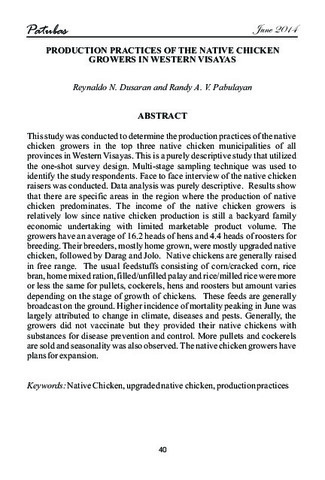Ipakita ang simpleng tala ng item
Production practices of the native chicken growers in Western Visayas
| dc.contributor.author | Dusaran, Reynaldo N. | |
| dc.contributor.author | Pabulayan, Randy Anthony V. | |
| dc.date.accessioned | 2020-12-29T05:52:07Z | |
| dc.date.available | 2020-12-29T05:52:07Z | |
| dc.date.issued | 2012-6 | |
| dc.identifier.citation | Dusaran, R. N., & Pabulayan, R. A. V. (2012). Production practices of the native chicken growers in Western Visayas. Patubas, 7(1), 40-65. | en_US |
| dc.identifier.issn | 1908-515X | |
| dc.identifier.uri | https://hdl.handle.net/20.500.12852/54 | |
| dc.description.abstract | This study was conducted to determine the production practices of the native chicken growers in the top three native chicken municipalities of all provinces in Western Visayas. This is a purely descriptive study that utilized the one-shot survey design. Multi-stage sampling technique was used to identify the study respondents. Face to face interview of the native chicken raisers was conducted. Data analysis was purely descriptive. Results show that there are specific areas in the region where the production of native chicken predominates. The income of the native chicken growers is relatively low since native chicken production is still a backyard family economic undertaking with limited marketable product volume. The growers have an average of 16.2 heads of hens and 4.4 heads of roosters for breeding. Their breeders, mostly home grown, were mostly upgraded native chicken, followed by Darag and Jolo. Native chickens are generally raised in free range. The usual feedstuffs consisting of corn/cracked corn, rice bran, home mixed ration, filled/unfilled palay and rice/milled rice were more or less the same for pullets, cockerels, hens and roosters but amount varies depending on the stage of growth of chickens. These feeds are generally broadcast on the ground. Higher incidence of mortality peaking in June was largely attributed to change in climate, diseases and pests. Generally, the growers did not vaccinate but they provided their native chickens with substances for disease prevention and control. More pullets and cockerels are sold and seasonality was also observed. The native chicken growers have plans for expansion. | en_US |
| dc.language.iso | en | en_US |
| dc.publisher | Central Philippine University | en_US |
| dc.subject.lcsh | Chicken breeders | en_US |
| dc.subject.lcsh | Chickens | en_US |
| dc.subject.lcsh | Philippines--Western Visayas | en |
| dc.subject.lcsh | Chicken industry | en |
| dc.title | Production practices of the native chicken growers in Western Visayas | en_US |
| dc.type | Article | en_US |
| dc.citation.firstpage | 40 | en_US |
| dc.citation.lastpage | 65 | en_US |
| dc.citation.journaltitle | Patubas | |
| dc.citation.volume | 7 | en_US |
| dc.citation.issue | 1 | en_US |
| local.subject | Native chicken | en_US |
| local.subject | Production practices | en_US |
| local.subject.scientificname | Gallus gallus | en |
| local.relation.associatedcontent | https://hdl.handle.net/20.500.12852/859 Research report | en |
Mga file sa item na ito
Lumilitaw ang item na ito sa mga sumusunod na (mga) Koleksyon
-
Patubas [110]
Patubas is a refereed research journal of Central Philippine University.





